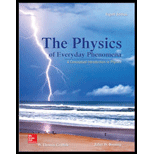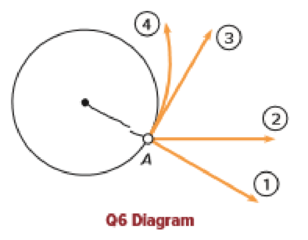
The Physics of Everyday Phenomena
8th Edition
ISBN: 9780073513904
Author: W. Thomas Griffith, Juliet Brosing Professor
Publisher: McGraw-Hill Education
expand_more
expand_more
format_list_bulleted
Textbook Question
Chapter 5, Problem 6CQ
A ball on the end of a string is whirled with constant speed in a counterclockwise horizontal circle. At point A in the circle, the string breaks. Which of the curves sketched in the diagram most accurately represents the path that the ball will take after the string breaks (as seen from above)? Explain.

Expert Solution & Answer
Want to see the full answer?
Check out a sample textbook solution
Students have asked these similar questions
In the swing carousel amusement park ride, riders sit in chairs that are attached by a chain to a large rotating drum as shown in (Figure 1). As the carousel turns, the riders move in a large circle with the chains tilted out from the vertical. In one such carousel, the riders move in a 15-m-radius circle and take 8.3 s to complete one revolution.
What is the angle of the chains, as measured from the vertical?
Does an object moving in a circle accelerate? If so, does the magnitude of the acceleration change with time? Explain your reasoning. Use an acceleration equation to support your claim.
The diagram shows the top view of a 65-kilogram student
at point A on an amusement park ride. The ride spins
the student in a horizontal circle of radius 2.5 meters, at
a constant speed of 8.6 meters per second. The floor is
lowered and the student remains against the wall without
falling to the floor.
2.5 m
Student
A
Which vector best represents the direction of the cen-
tripetal acceleration of the student at point A?
(1)
(2)
(3)
(4)
01
Chapter 5 Solutions
The Physics of Everyday Phenomena
Ch. 5 - Suppose that the speed of a ball moving in a...Ch. 5 - A car travels around a curve with constant speed....Ch. 5 - Two cars travel around the same curve, one at...Ch. 5 - A car travels the same distance at constant speed...Ch. 5 - The centripetal acceleration depends upon the...Ch. 5 - A ball on the end of a string is whirled with...Ch. 5 - Before the string breaks in question 6, is there a...Ch. 5 - For a ball being twirled in a horizontal circle at...Ch. 5 - A car travels around a flat (nonbanked) curve with...Ch. 5 - Is there a maximum speed at which the car in...
Ch. 5 - If a curve is banked, is it possible for a car to...Ch. 5 - If a ball is whirled in a vertical circle with...Ch. 5 - Sketch the forces acting upon a rider on a Ferris...Ch. 5 - Which safety measure, seat belts or air bags,...Ch. 5 - In a head-on collision between two vehicles, is...Ch. 5 - If a car is equipped with air bags, should it be...Ch. 5 - In what way did the heliocentric view of the solar...Ch. 5 - Did Ptolemys view of the solar system require...Ch. 5 - Heliocentric models of the solar system...Ch. 5 - How did Keplers view of the solar system differ...Ch. 5 - Consider the method of drawing an ellipse pictured...Ch. 5 - Does a planet moving in an elliptical orbit about...Ch. 5 - Does the sun exert a larger force on the Earth...Ch. 5 - Is there a net force acting on the planet Earth?...Ch. 5 - Three equal masses are located as shown in the...Ch. 5 - Two masses are separated by a distance r. If this...Ch. 5 - A painter depicts a portion of the night sky as...Ch. 5 - At what times during the day or night would you...Ch. 5 - At what times of the day or night does the...Ch. 5 - Are we normally able to see the new moon? Explain.Ch. 5 - During what phase of the moon can a solar eclipse...Ch. 5 - A synchronous satellite is one that does not move...Ch. 5 - Is Keplers third law valid for artificial...Ch. 5 - Since the Earth rotates on its axis once every 24...Ch. 5 - Prob. 35CQCh. 5 - Prob. 36CQCh. 5 - Prob. 1ECh. 5 - Prob. 2ECh. 5 - Prob. 3ECh. 5 - Prob. 4ECh. 5 - Prob. 5ECh. 5 - Prob. 6ECh. 5 - Prob. 7ECh. 5 - Prob. 8ECh. 5 - Prob. 9ECh. 5 - Prob. 10ECh. 5 - Prob. 11ECh. 5 - Prob. 12ECh. 5 - Prob. 13ECh. 5 - Prob. 14ECh. 5 - Prob. 15ECh. 5 - Prob. 16ECh. 5 - Prob. 1SPCh. 5 - Prob. 2SPCh. 5 - Prob. 3SPCh. 5 - Prob. 4SPCh. 5 - Prob. 5SPCh. 5 - Prob. 6SP
Knowledge Booster
Learn more about
Need a deep-dive on the concept behind this application? Look no further. Learn more about this topic, physics and related others by exploring similar questions and additional content below.Similar questions
- A car on a highway is heading toward a cloverleaf interchange with a circular curvature or Radius=50 m, traveling at a steady speed of 14m/s. A) determine the position and velocity of the vehicle at points A and B. B) determine the vector components and direction of the average acceleration during the trip from a to b. Include a sketch of the vector showing it's orientation. SPeciffy the direction between -180 degrees and 180 degrees as measured from the +x axis.arrow_forwardDoes an object moving in a circle accelerate? If so, does the magnitude of the acceleration change with time? Explain your reasoningarrow_forwardConsider a roller coaster loop. Are the roller coaster cars traveling through the loop inuniform circular motion? Explain.arrow_forward
- Suppose that a Ferris wheel with radius R = 25 m is rotating clockwise and that the point P at angle 45° has acceleration vector a = (0, -70) m/min² pointing down, as in the figure. Determine the speed v and tangential acceleration at of the Ferris wheel. Ferris wheel (Use decimal notation. Give your answers to two decimal places.) at ≈ 450 ប ~ 2 m/min m/minarrow_forwardJan standing at a stationary point directly in front of the center of a bull's eye, aims two arrows at the bull's eye. The first arrow hits one point on the edge of the bull's eye while the second strikes the center of the bull's eye. Jan knows that the second arrow traveled 20 meter distance since he knows where he is from the target. Assuming the bull's eye to be circular of radius 4 meters, how far did the first arrow travel? Neglect gravitational force. A. 20.8 m B. 20.1 m C. 20.4 m D. 20.6 marrow_forwardThe data given below comes from 2006 NASA space shuttle mission flown by the space shuttle Discovery. Plot the following quantities as a function of time Altitude Velocity Acceleration The radial velocity of the space shuttle is the component of the velocity that points in the direction of the radius connecting the shuttle to Earth’s center. From your altitude versus time graph, estimate the radial speed at t= 40 s t=80 s t=120 sarrow_forward
- A ball is traveling at a constant speed (v) of 40.0 m/s in a circle with a radius (r) of 6.0 m. (Hint: The circumference C = 2πr) The centripetal acceleration is ZERO a. False b. True The total distance traveled by the ball is: How long in time does it take for the ball complete one circle? The displacement traveled by the ball is: The average speed of the ball is: The average velocity of the ball is:arrow_forwardImagine a CD with an outer radius of 12 mm and an inner radius of 2 mm. A speck of dust on the outer edge completes a full revolution in 0.5 seconds. A speck of glitter on the inner edge completes a full revolution in 0.2 seconds. a) What is the centripetal acceleration of the dust in m/s2? b) What is the centripetal acceleration of the glitter in m/s2?arrow_forwardA person has a yo-yo and spins the yo-yo at constant speed in a horizontal circular path of radius R. The yo-yo completes each revolution of its motion in a time period T. What is the magnitude of the acceleration of the yo-yo? -options are in one of the imagesarrow_forward
- An undiscovered planet, many lightyears from Earth, has one moon in a periodic orbit. This moon takes 20.0 days on average to complete one nearly circular revolution around the unnamed planet. If the distance from the center of the moon to the surface of the planet is 2.420 × 10° km and the planet has a radius of 4.100 × 10³ km, calculate the moon's radial acceleration a. a = m/s? & TOOLS x10arrow_forwardA toy plane is connected to a string. You hold the free end of the string and whirl the plane horizontal circle in such a way that the plane is in uniform circular motion. Which of the following statements are true for this situation? (Select all that apply) i. The plane's speed is constant. ii. The direction of the plane's velocity changes as it moves around the circle. iii. The magnitude of the plane's velocity does not change. iv. The plane is moving with constant velocity. v. The change in direction of the plane's motion is due to the centripetal force acting on the plane.arrow_forwardA boy whirls a stone in a horizontal circle of radius 1.83 m and at height 2.38 m above level ground. The string breaks, and the stone flies off horizontally and strikes the ground after traveling a horizontal distance of 9.15 m. What is the magnitude of the centripetal acceleration of the stone while in circular motion? Use g=9.81 m/s?. Number i Unitsarrow_forward
arrow_back_ios
SEE MORE QUESTIONS
arrow_forward_ios
Recommended textbooks for you
 Physics for Scientists and Engineers: Foundations...PhysicsISBN:9781133939146Author:Katz, Debora M.Publisher:Cengage Learning
Physics for Scientists and Engineers: Foundations...PhysicsISBN:9781133939146Author:Katz, Debora M.Publisher:Cengage Learning

Physics for Scientists and Engineers: Foundations...
Physics
ISBN:9781133939146
Author:Katz, Debora M.
Publisher:Cengage Learning
Vectors and 2D Motion: Crash Course Physics #4; Author: CrashCourse;https://www.youtube.com/watch?v=w3BhzYI6zXU;License: Standard YouTube License, CC-BY